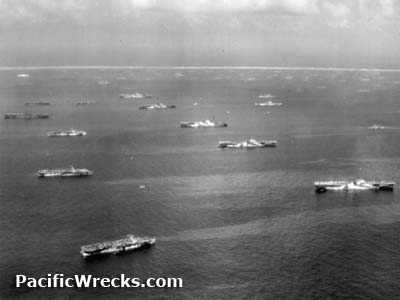|
|
|
|
| Missing In Action (MIA) | Prisoners Of War (POW) | Unexploded Ordnance (UXO) |
| Chronology | Locations | Aircraft | Ships | Submit Info | How You Can Help | Donate |
|
 USN December 8, 1944  USN March 13, 1945 |
Location Ulithi Lagoon (Urushi Lagoon) located at the center of Ulithi Atoll (Urushi Atoll). Also known as Ulithi Anchorage or Urushi Anchorage. Ulithi Lagoon is the world's fourth largest lagoon with an area of 209 square miles. The lagoon has a number of channels into the lagoon, on the eastern side is Mugai Channel and Hanimarin Channel. Prewar and during the Pacific War part of the western Caroline Islands. American code name "Mackenzie". Today located in in Yap State in the Federated States of Micronesia. Wartime History During the Pacific War, Occupied by the Japanese and used to a limited degree until abandoned by September 1944. During 1944, U.S. Navy (USN) carrier aircraft conducted combat missions and photo intelligence against Ulithi. American missions against Ulithi March 30, 1944–September 20, 1944 On September 20, 1944 occupied by U.S. Army 81st Infantry Division without opposition. Afterwards, developed into a U.S. Navy (USN) anchorage for warships and transports. The lagoon was divided into 834 berths of three sizes for different types of vessels. Berth Numbers 1-100 were 1,000 yards in diameter for the largest vessels. Berth Numbers 101 to 400 were 700 yard in diameter for medium sized vessels. Berth Number 401-834 were 400 yards in diameter for smaller vessels. On October 10, 1944 the 8th Naval Construction Battalion (88th CB) "Seabees" began work on support facilities at Ulithi and a new type of pontoon pier constructed from 4' x 12' pontoon sections filled with sand and gravel were sunk and anchored in place by guy ropes to deadmen on shore and by iron rods, driven into the coral, with connecting tie pieces running across the tops of the pontoons. Despite extremely heavy weather on several occasions, these pontoon piers stood up remarkably well, giving extensive service, with few repairs necessary. Shore based facilities included 42 quonset huts for use as a receiving station and a mess hall for 1,600 men with galley, warehouses and refrigeration units. Additional facilities included the Ulithi Atoll commander's headquarters, a dispensary, administration building, a shop and Marine aviation camp. The 88th Seabees continued to develop and improve the facilities until they departed on February 7, 1945 for Samar. Japanese missions against Ulithi November 20, 1944–March 11, 1945 On November 20, 1944 the "Kikusui Group" (Floating Chrysanthemum Group) including I-36 and I-47 transporting four Kaiten each conduct the first Kaiten (manned torpedo) mission against Ulithi. In the early in the morning, I-47 east of Lossau Island launched all four Kaitens including Kaiten No. 1 pilot Lt(jg) Nishina Sekio, Kaiten No. 2 piloted by Ensign Sato Akira, Kaiten No. 3 piloted Ensign Watanabe Kozo and Kaiten No. 4 pilot Lt(jg) Fukuda Hitoshi. I-36 submerged to 30' further to the northeast and launced only Kaiten No. 3 Kaiten piloted by Ensign Taichi at 4:54 a.m. The other three fail to launch due to malfunctions: two are stuck in their chocks and the third's engine experienced a leak. The other three disappointed kaiten pilots pressed Lt. Cmdr Teramoto to resurface at a safe distance and attempt to repair their kaiten torpedoes for a follow-up strike; but a wide-ranging depth charge hunt by US warships after the attack forced I-36 to remain submerged until late into the night then after recharging her batteries, departs bound for Leyte Gulf. Of the five Kaiten launched, three were lost or destroyed outside with only two entering the lagoon. The precise fte of each Kaiten is known but not their pilots. The first Kaiten exploded on the fringing reef. A second Kaiten foundered outside the reef and was sunk by aircraft. A third was rammed by USS Case (DD-370) at the entrance to Mugai Channel. Of the two that entered the lagoon, one was sunk by depth charges from USS Rall (DE-304). At 5:45am a Kaiten hit USS Mississinewa (AO-59) causing an explosion that resulted in the ship capsizing and sinking after 8:30am. It is generally believed to have been Kaiten No. 1 piloted by Lt(jg) Nishina Sekio. USS Mississinewa (AO-59) Sunk by Kaiten attack November 20, 1944 Operation Tan No. 2 Kamikaze Attack March 11, 1945 On March 11, 1945 twenty-four P1Y1 Ginga (Frances) took off from Japan on a mission against U.S. carriers anchored in Ulithi Lagoon but only two managed to reach the target area, approaching at high altitude. They dropped tin foil chaff to deceive American radars. then dove and flew in low over the water and both Gingas flew into the anchorage undetected and the ships and islands fully illuminated and no red alert was sounded. The first P1Y Ginga radioed "successful attack!” before crashing at 8:07pm into USS Randolph (CV-15) off Sorlen Island. The second Ginga mistook Sorlen Island for an aircraft carrier and crashed into a warehouse on the island. Postwar During 1947, the U.S. Navy departed Ulithi Anchorage. Contribute
Information Last Updated
|
June 1945 Photo Archive |
| Discussion Forum | Daily Updates | Reviews | Museums | Interviews & Oral Histories |
|